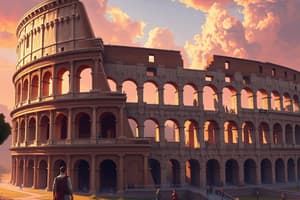Podcast
Questions and Answers
What major event was the Colosseum primarily built for?
What major event was the Colosseum primarily built for?
- Gladiatorial combat (correct)
- Theater performances
- Public speeches
- Religious ceremonies
Which engineering feature was crucial for audience management in the Colosseum?
Which engineering feature was crucial for audience management in the Colosseum?
- Solid walls
- Elevated seating areas
- Open-air design
- Complex system of pulleys and ramps (correct)
What was the purpose of the hypogeum in the Colosseum?
What was the purpose of the hypogeum in the Colosseum?
- To hold public meetings
- To serve as a restroom
- To store food supplies
- To house gladiators and animals (correct)
During which period was the Colosseum constructed?
During which period was the Colosseum constructed?
What advanced feature did the Colosseum have for water management?
What advanced feature did the Colosseum have for water management?
Who commissioned the construction of the Cloaca Maxima?
Who commissioned the construction of the Cloaca Maxima?
What was the primary reason for building the Cloaca Maxima?
What was the primary reason for building the Cloaca Maxima?
During what century was the Cloaca Maxima constructed?
During what century was the Cloaca Maxima constructed?
What is the primary function of the Cloaca Maxima in ancient Rome?
What is the primary function of the Cloaca Maxima in ancient Rome?
Which ancient structure is noted for its extensive fortifications against invasions?
Which ancient structure is noted for its extensive fortifications against invasions?
What was a key feature of the Cloaca Maxima that aided in waste movement?
What was a key feature of the Cloaca Maxima that aided in waste movement?
What innovative design is the Zhaozhou Bridge known for?
What innovative design is the Zhaozhou Bridge known for?
How long is the main tunnel of the Cloaca Maxima?
How long is the main tunnel of the Cloaca Maxima?
What significant feature does the Great Wall of China have?
What significant feature does the Great Wall of China have?
What was a common power source for the pumps used in the Cloaca Maxima?
What was a common power source for the pumps used in the Cloaca Maxima?
Which river served as a source for the Cloaca Maxima's wastewater collection?
Which river served as a source for the Cloaca Maxima's wastewater collection?
What was the primary purpose of the Temple of Karnak?
What was the primary purpose of the Temple of Karnak?
How long did the construction of the Temple of Karnak take?
How long did the construction of the Temple of Karnak take?
What was the primary purpose of the Great Ziggurat of Ur?
What was the primary purpose of the Great Ziggurat of Ur?
Which god was the Temple of Karnak dedicated to?
Which god was the Temple of Karnak dedicated to?
How many levels did the Great Ziggurat of Ur have?
How many levels did the Great Ziggurat of Ur have?
What materials were primarily used for the construction of the Temple of Karnak?
What materials were primarily used for the construction of the Temple of Karnak?
Approximately when was the Great Ziggurat of Ur completed?
Approximately when was the Great Ziggurat of Ur completed?
What design feature is characteristic of the Temple of Karnak?
What design feature is characteristic of the Temple of Karnak?
During which period did the earliest structures of the Temple of Karnak date back to?
During which period did the earliest structures of the Temple of Karnak date back to?
What materials were primarily used in the construction of the Great Ziggurat of Ur?
What materials were primarily used in the construction of the Great Ziggurat of Ur?
What innovative feature did the Walls of Babylon include?
What innovative feature did the Walls of Babylon include?
What is the total area covered by the Temple of Karnak complex?
What is the total area covered by the Temple of Karnak complex?
What aspect of the Temple of Karnak's construction involved individual contributions?
What aspect of the Temple of Karnak's construction involved individual contributions?
Who commissioned the construction of the Walls of Babylon?
Who commissioned the construction of the Walls of Babylon?
In what year did the construction of the Walls of Babylon begin?
In what year did the construction of the Walls of Babylon begin?
What type of material was used to bind the bricks together in the construction of the Walls of Babylon?
What type of material was used to bind the bricks together in the construction of the Walls of Babylon?
What was the primary purpose of the temple complex in ancient Egypt?
What was the primary purpose of the temple complex in ancient Egypt?
Which feature of the temple complex was used for purification rituals?
Which feature of the temple complex was used for purification rituals?
What was the purpose of the obelisks in the temple complex?
What was the purpose of the obelisks in the temple complex?
How did ancient Egyptian farmers utilize the Nile River for agriculture?
How did ancient Egyptian farmers utilize the Nile River for agriculture?
Which crops did ancient Egyptian farmers grow on a large scale?
Which crops did ancient Egyptian farmers grow on a large scale?
What role did the temple complex play in relation to pharaohs?
What role did the temple complex play in relation to pharaohs?
What technique did ancient Egyptians use to manage floodwater from the Nile?
What technique did ancient Egyptians use to manage floodwater from the Nile?
Which of the following statements about the temple complex is TRUE?
Which of the following statements about the temple complex is TRUE?
Flashcards are hidden until you start studying
Study Notes
Colosseum
- Built from 72-80 CE during Emperor Vespasian's reign, designed for gladiatorial combat, animal hunts, and public entertainment.
- Features an advanced engineering design with pulleys, counterweights, and ramps for efficient crowd movement and quick set changes.
- Contains a hypogeum (underground chambers) used to house gladiators, animals, and stage machinery.
- Equipped with a sophisticated water system, including aqueducts, fountains, and a network of pipes for hydration.
Cloaca Maxima
- Constructed around the 6th century BCE under King Tarquinius Priscus to drain swamps and improve sanitation in early Rome.
- Remarkable engineering achievement, still functional after 2,500 years, featuring:
- A 1.5 km (0.9 miles) main tunnel, with a diameter of 1-3 meters (3-10 feet).
- Gentle slopes to utilize gravity for waste movement.
- Manual or animal-powered pumping stations to aid waste transportation.
- Catchment areas that collect wastewater from the Tiber River and surrounding streams.
Great Wall of China
- An extensive fortification system built to protect against invasions, stretching over 13,170 miles (21,200 km).
- Construction started in the 7th century BCE, with initial walls built during the Chu State period.
- Demonstrates advanced large-scale construction techniques in ancient engineering.
Temple of Karnak
- Constructed over 4,000 years with earliest structures dating back to 1600 BCE during the New Kingdom.
- Temples designed around a central axis, consisting of various courtyards and halls, covering 250 acres (100 hectares).
- Built primarily with limestone and granite, serving as a worship site for the god Amun and symbolizing pharaohs' power.
- Used for rituals, sacrifices, and as burial sites, featuring sacred lakes for purification and obelisks for divine authority.
Nile River Irrigation System
- Ancient Egyptian farmers developed basin irrigation to maximize the Nile's waters for agriculture, particularly wheat, barley, and flax.
- Constructed earthen banks to create basins and dug channels to direct floodwaters, allowing soil saturation for planting.
Great Ziggurat of Ur
- Built around 2100 BCE during the Ur III dynasty as a temple complex dedicated to the moon god Nanna.
- Constructed from mud-brick and sun-dried bricks, with a base perimeter of approximately 215 meters (705 feet) and seven decreasing levels.
- Served as a connection point between heaven and earth for Sumerian worship and rituals.
Walls of Babylon
- Constructed by Nebuchadnezzar II around 575 BCE, taking approximately 14 years to complete.
- Built from limestone and bound with bitumen, showcasing impressive strength and durability.
- Featured a complex system of gates, towers, and fortifications, representing a significant feat of ancient engineering.
Studying That Suits You
Use AI to generate personalized quizzes and flashcards to suit your learning preferences.



